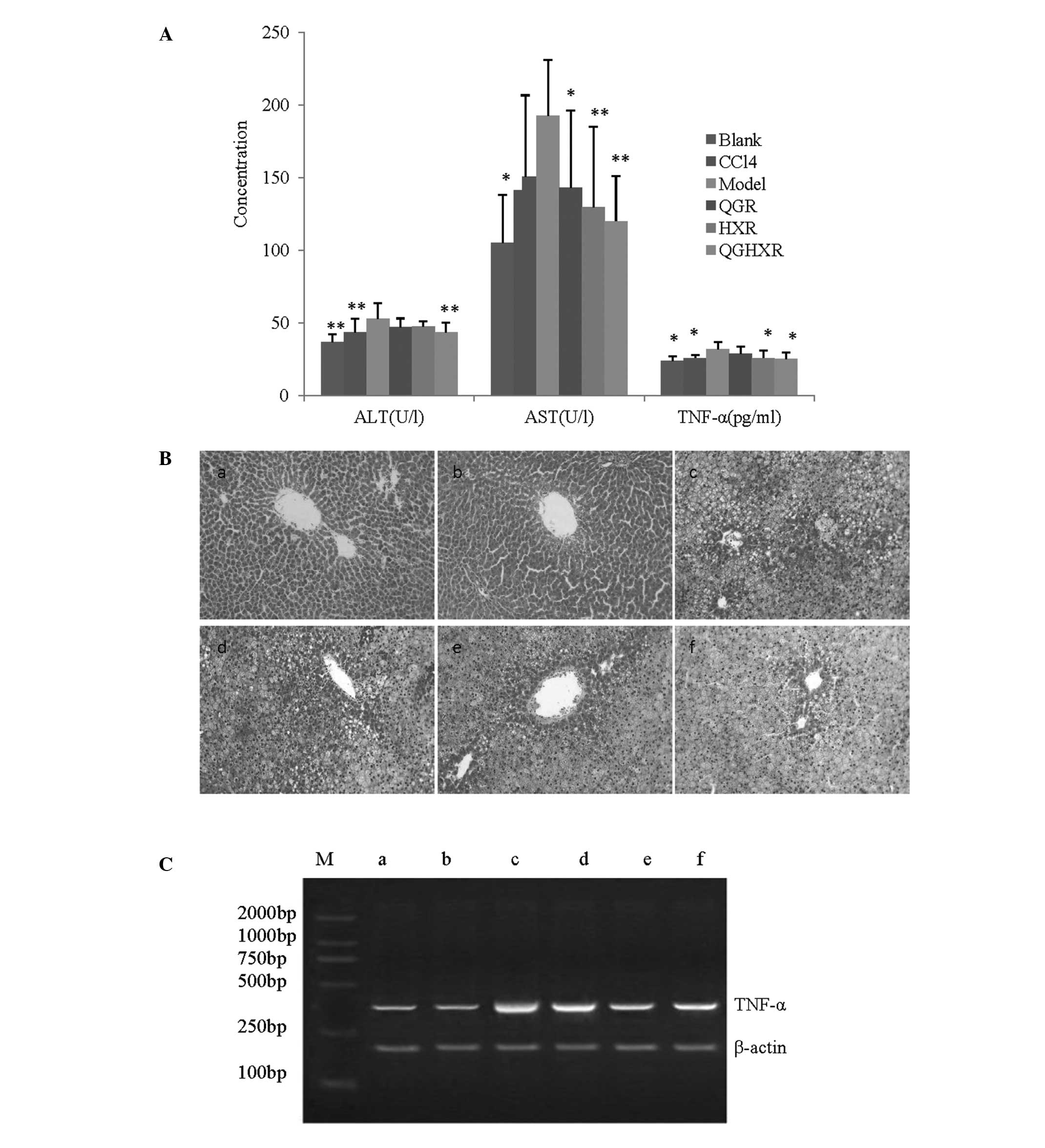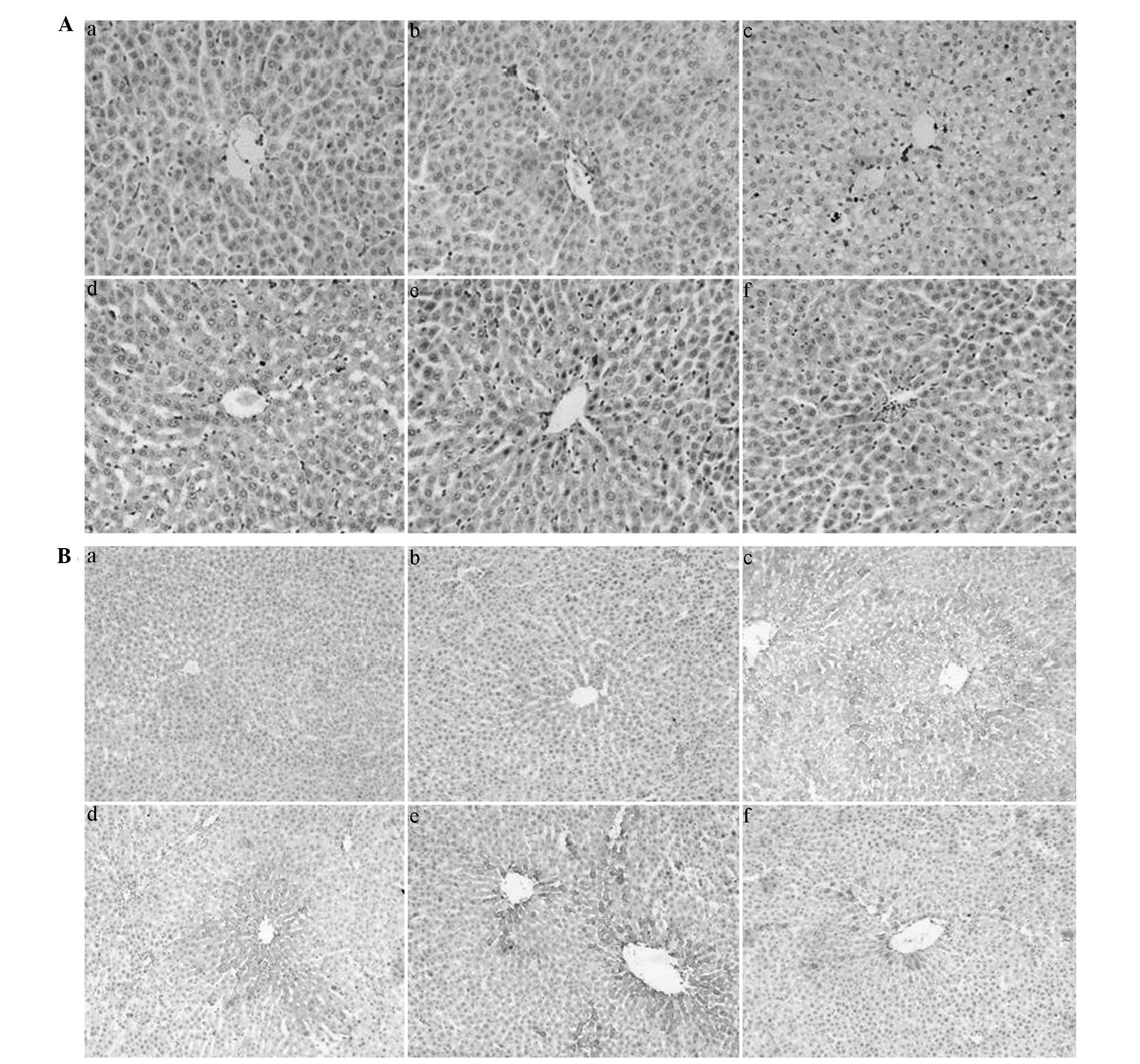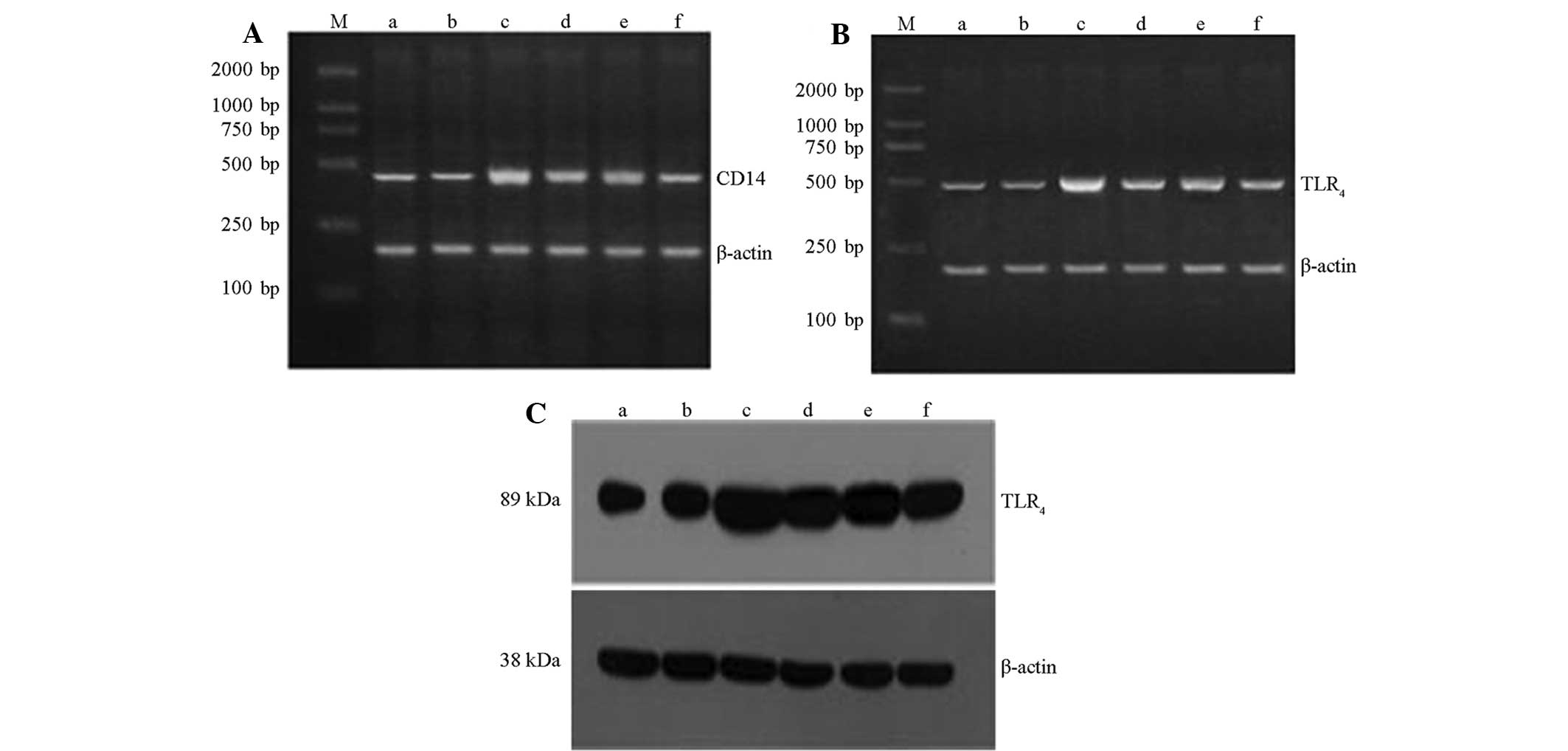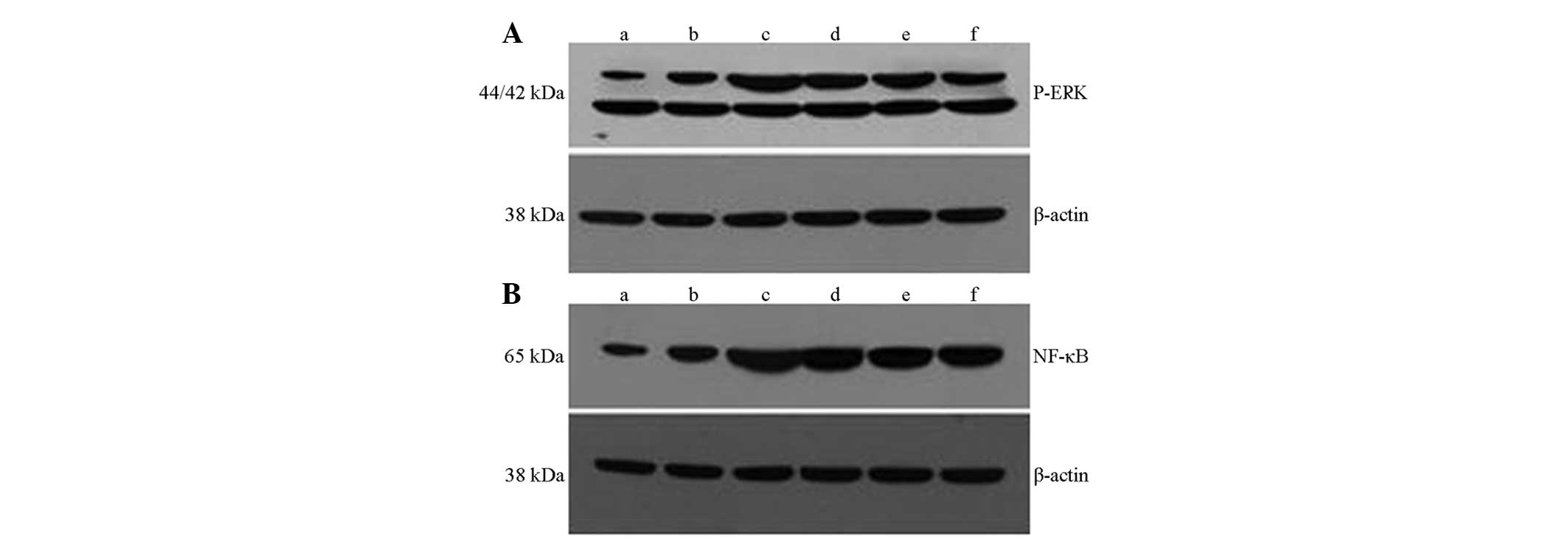|
1
|
Rao RK, Seth A and Sheth P: Recent
advances in alcoholic liver disease I. Role of intestinal
permeability and endotoxemia in alcoholic liver disease. Am J
Physiol Gastrointest Liver Physiol. 286:G881–G884. 2004. View Article : Google Scholar : PubMed/NCBI
|
|
2
|
Albano E: Oxidative mechanisms in the
pathogenesis of alcoholic liver disease. Mol Aspects Med. 29:9–16.
2008. View Article : Google Scholar : PubMed/NCBI
|
|
3
|
Nagy LE: Recent insights into the role of
the innate immune system in the development of alcoholic liver
disease. Exp Biol Med (Maywood). 228:882–890. 2003.PubMed/NCBI
|
|
4
|
Mandrekar P and Szabo G: Signalling
pathways in alcohol-induced liver inflammation. J Hepatol.
50:1258–1266. 2009. View Article : Google Scholar : PubMed/NCBI
|
|
5
|
O’Shea RS, Dasarathy S and McCullough AJ;
Practice Guideline Committee of the American Association for the
Study of Liver Diseases; Practice Parameters Committee of the
American College of Gastroenterology. Alcoholic liver disease.
Hepatology. 51:307–328. 2010.
|
|
6
|
Ji G, Wang YQ and Cao CL: Clinical study
on treatment of alcoholic liver disease by qinggan huoxue recipe.
Zhongguo Zhong Xi Yi Jie He Za Zhi. 24:13–16. 2004.(In
Chinese).
|
|
7
|
Lu YL, Wang M and Ji G: Determination of
Puerarin, Baicalin, Baicalein and Wogonin in Qinggan Huoxue Recipe
by HPLC. Chin Pharm J. 45:299–301. 2010.
|
|
8
|
Wang L, Ji G, Zheng PY and Long AH:
Establishment of a rat model of alcoholic liver fibrosis induced by
complex factors. Zhong Xi Yi Jie He Xue Bao. 4:281–284. 2006.
View Article : Google Scholar : PubMed/NCBI
|
|
9
|
Diehl AM, Goodman Z and Ishak KG: Alcohol
like disease in nonalcoholics. A clinical and histologic comparison
with alcohol-induced liver injury. Gastroenterology. 95:1056–1062.
1988.PubMed/NCBI
|
|
10
|
Wang TL: The classification, staging and
and categorization of the pathologic diagnostic criteria of
alcoholic liver disease. Zhong Hua Gan Zang Bin Za Zhi. 5:312–313.
2001.
|
|
11
|
Lv XH, Zhou LP, Liu DP, et al: Traditional
Chinese medicine Kang Xian Fu Fang I is effective for prophylaxis
and treatment of alcoholic liver disease in rats. Hepatobiliary
Pancreat Dis Int. 6:182–187. 2007.PubMed/NCBI
|
|
12
|
Enomoto N, Ikejima K, Yamashina S, et al:
Kupffer cell sensitization by alcohol involves increased
permeability to gut-derived endotoxin. Alcohol Clin Exp Res. 25(6
Suppl): 51S–54S. 2001. View Article : Google Scholar : PubMed/NCBI
|
|
13
|
Wheeler MD and Thurman RG: Up-regulation
of CD14 in liver caused by acute ethanol involves oxidant-dependent
AP-1 pathway. J Biol Chem. 278:8435–8441. 2003. View Article : Google Scholar : PubMed/NCBI
|
|
14
|
Hines IN and Wheeler MD: Recent advances
in alcoholic liver disease III. Role of the innate immune response
in alcoholic hepatitis. Am J Physiol Gastrointest Liver Physiol.
287:G310–G314. 2004. View Article : Google Scholar : PubMed/NCBI
|
|
15
|
Purohit V, Gao B and Song BJ: Molecular
mechanisms of alcoholic fatty liver. Alcohol Clin Exp Res.
33:191–205. 2009. View Article : Google Scholar : PubMed/NCBI
|
|
16
|
Thurman RG: II. Alcoholic liver injury
involves activation of Kupffer cells by endotoxin. Am J Physiol.
275:G605–G611. 1998.PubMed/NCBI
|
|
17
|
Song Z, Zhou Z, Uriarte S, et al:
S-adenosylhomocysteine sensitizes to TNF-alpha hepatotoxicity in
mice and liver cells: a possible etiological factor in alcoholic
liver disease. Hepatology. 40:989–997. 2004. View Article : Google Scholar : PubMed/NCBI
|
|
18
|
Tilg H, Jalan R, Kaser A, et al:
Anti-tumor necrosis factor-alpha monoclonal antibody therapy in
severe alcoholic hepatitis. J Hepatol. 38:419–425. 2003. View Article : Google Scholar : PubMed/NCBI
|
|
19
|
Yin M, Wheeler MD, Kono H, et al:
Essential role of tumor necrosis factor alpha in alcohol-induced
liver injury in mice. Gastroenterology. 117:942–952. 1999.
View Article : Google Scholar : PubMed/NCBI
|
|
20
|
Olleros ML, Martin ML, Vesin D, et al: Fat
diet and alcohol-induced steatohepatitis after LPS challenge in
mice: role of bioactive TNF and Th1 type cytokines. Cytokine.
44:118–125. 2008. View Article : Google Scholar : PubMed/NCBI
|
|
21
|
Takeda K and Akira S: Toll-like receptors
in innate immunity. Int Immunol. 17:1–14. 2005. View Article : Google Scholar
|
|
22
|
Dunne A and O’Neill LA: Adaptor usage and
Toll-like receptor signaling specificity. FEBS Lett. 579:3330–3335.
2005. View Article : Google Scholar : PubMed/NCBI
|
|
23
|
Verbon A, Dekkers PE, ten Hove T, et al:
IC14, an anti-CD14 antibody, inhibits endotoxin-mediated symptoms
and inflammatory responses in humans. J Immunol. 166:3599–3605.
2001. View Article : Google Scholar : PubMed/NCBI
|
|
24
|
Lee JD, Kato K, Tobias PS, Kirkland TN and
Ulevitch RJ: Transfection of CD14 into 70Z/3 cells dramatically
enhances the sensitivity to complexes of lipopolysaccharide (LPS)
and LPS binding protein. J Exp Med. 175:1697–1705. 1992. View Article : Google Scholar : PubMed/NCBI
|
|
25
|
Saitoh S, Akashi S, Yamada T, et al: Lipid
A antagonist, lipid IVa, is distinct from lipid A in interaction
with Toll-like receptor 4 (TLR4)-MD-2 and ligand-induced
TLR4 oligomerization. Int Immunol. 16:961–969. 2004.
View Article : Google Scholar : PubMed/NCBI
|
|
26
|
Visintin A, Mazzoni A, Spitzer JA and
Segal DM: Secreted MD-2 is a large polymeric protein that
efficiently confers lipopolysaccharide sensitivity to Toll-like
receptor 4. Proc Natl Acad Sci USA. 98:12156–12161. 2001.
View Article : Google Scholar : PubMed/NCBI
|
|
27
|
Uesugi T, Froh M, Arteel GE, Bradford BU
and Thurman RG: Toll-like receptor 4 is involved in the mechanism
of early alcohol-induced liver injury in mice. Hepatology.
34:101–108. 2001. View Article : Google Scholar : PubMed/NCBI
|
|
28
|
Uesugi T, Froh M, Arteel GE, et al: Role
of lipopolysaccharide-binding protein in early alcohol-induced
liver injury in mice. J Immunol. 168:2963–2969. 2002. View Article : Google Scholar : PubMed/NCBI
|
|
29
|
Yin M, Bradford BU, Wheeler MD, et al:
Reduced early alcohol-induced liver injury in CD14-deficient mice.
J Immunol. 166:4737–4742. 2001. View Article : Google Scholar : PubMed/NCBI
|
|
30
|
Ghosh S: Regulation of inducible gene
expression by the transcription factor NF-kappaB. Immunol Res.
19:183–189. 1999. View Article : Google Scholar : PubMed/NCBI
|
|
31
|
Wheeler MD, Yamashina S, Froh M, Rusyn I
and Thurman RG: Adenoviral gene delivery can inactivate Kupffer
cells: role of oxidants in NF-kappaB activation and cytokine
production. J Leukoc Biol. 69:622–630. 2001.PubMed/NCBI
|
|
32
|
Yao J, Mackman N, Edgington TS and Fan ST:
Lipopolysaccharide induction of the tumor necrosis factor-alpha
promoter in human monocytic cells. Regulation by Egr-1, c-Jun, and
NF-kappaB transcription factors. J Biol Chem. 272:17795–17801.
1997. View Article : Google Scholar
|
|
33
|
Shi L, Kishore R, McMullen MR and Nagy LE:
Chronic ethanol increases lipopolysaccharide-stimulated Egr-1
expression in RAW 264.7 macrophages: contribution to enhanced tumor
necrosis factor alpha production. J Biol Chem. 277:14777–14785.
2002.
|
|
34
|
Karki R, Park CH and Kim DW: Extract of
buckwheat sprouts scavenges oxidation and inhibits pro-inflammatory
mediators in lipopolysaccharide-stimulated macrophages (RAW264.7).
J Integr Med. 11:246–252. 2013. View Article : Google Scholar : PubMed/NCBI
|
|
35
|
Nwozo SO, Osunmadewa DA and Oyinloye BE:
Anti-fatty liver effects of oils from Zingiber officinale
and Curcuma longa on ethanol-induced fatty liver in rats. J
Integr Med. 12:59–65. 2014.PubMed/NCBI
|


















